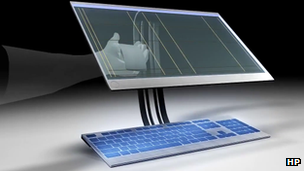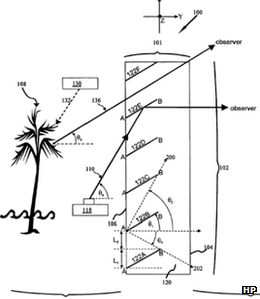HP's see-through screen proposals secure US patent
- Published

One HP concept design shows a screen that superimposes data over objects held behind it
Hewlett Packard has been granted a US patent for its see-through screen technology.
The firm describes a system to create transparent displays that would allow users to see both the screen's computer graphics and the backdrop of the room or an object behind the device.
Possible uses include navigation data shown on vehicle windscreens and adverts shown on windows.
Samsung is also known to be working on similar technology.
Slat system
The patent <link> <caption>was filed in 2006</caption> <url href="http://patft1.uspto.gov/netacgi/nph-Parser?Sect1=PTO1&Sect2=HITOFF&d=PALL&p=1&u=%2Fnetahtml%2FPTO%2Fsrchnum.htm&r=1&f=G&l=50&s1=8,212,744.PN.&OS=PN/8,212,744&RS=PN/8,212,744" platform="highweb"/> </link> and describes using light-reflective slats to display images produced by a computer on a transparent screen while also allowing light from behind the device to shine through.
HP acknowledges that alternative see-through technology using angled half-silvered mirrors is already used by TV broadcasters in teleprompters to allow newsreaders to see text superimposed over camera lenses.
While such systems coped well with text or images formed by bright lines, HP said, they struggled with greyscale or full-colour graphics.

HP's patent filing suggests how both graphics and background objects could be seen at the same time
The firm said its proposal should overcome this problem and added that those behind the screen could also shown different images in order to overcome privacy concerns.
The patent's authors also suggested the user might opt to place the display directly against an object in order to superimpose information.
This could be a "chart, picture or other image," they wrote, "For example [the] see-through display may be placed upon a map so as to provide an observer with a navigation route."
They added that it might be advantageous to make such screens flexible so that they could be rolled away for storage.
Sci-fi props
Although HP has yet to put this technology to use, it released videos last year showing concept designs provided to the makers of the movie Real Steel.
These included <link> <caption>the ThruScreen</caption> <url href="http://www.youtube.com/watch?v=WLWOMAi4JqY&feature=player_embedded" platform="highweb"/> </link> , designed to allows descriptive data to appear over a scanned object held behind the device.
Another showed <link> <caption>the HP Flex</caption> <url href="http://www.youtube.com/watch?v=3FRh3Jsb_tc&feature=plcp" platform="highweb"/> </link> , a laptop computer whose screen allows a sports trainer to see live data about his team projected over his view of their performance.
The company is not the only one exploring the idea.
Samsung's mobile unit released a video last year showing an imagined <link> <caption>transparent, bendable tablet computer</caption> <url href="http://www.youtube.com/watch?v=f4AhTiQkWwk&feature=player_embedded" platform="highweb"/> </link> that could be held over signs and objects to reveal more information about them.

The HP Flex allowed Hugh Jackman's character to monitor a robot boxer in the film Real Steel
The South Korean firm has also showed off a prototype laptop with a transparent OLED (organic light-emitting diode) screen, at the Consumer Electronics Show in Las Vegas.
Potential profits
One analyst who had been shown HP's work on the technology at its Palo Alto, California research lab said the firm was serious about the technology.
"HP has been working on trying to perfect this technology for about two decades," said Chris Green, principal technology analyst at Davies Murphy Group Europe.
"There's many real world applications, from augmented reality to displaying information on flat surfaces such as web browsers on windows or heads-up displays in cars.
"It may look gimmicky in the movies but there's huge financial potential in this if you can get the technology right and sell it for an acceptable price."
- Published2 July 2012
- Published8 March 2012
- Published8 March 2012